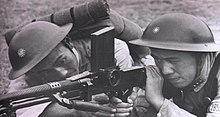
The Bren gun was a series of light machine guns (LMG) made by Britain in the 1930s and used in various roles until 1992. While best known for its role as the British and Commonwealth forces' primary infantry LMG in World War II, it was also used in the Korean War and saw service throughout the latter half of the 20th century, including the 1982 Falklands War. Although fitted with a bipod, it could also be mounted on a tripod or be vehicle-mounted.

The vz. 52 rifle is a self-loading rifle developed shortly after the Second World War in Czechoslovakia. Its full name is 7,62mm samonabíjecí puška vzor 52. Vz. 52 is an abbreviation for vzor 52, meaning "model 52". It fires the unique 7.62×45mm cartridge. It is considered both reliable and accurate. The first 5000 vz. 52 rifles were made by Považské strojárne in Považská Bystrica, but due to production difficulties, its manufacture was taken over by Česká zbrojovka Uherský Brod.

The Type 96 light machine gun was a light machine gun used by the Imperial Japanese Army in the interwar period and in World War II. It was first introduced in 1936, and fires the 6.5x50mm Arisaka from 30-round top-mounted magazines. A combination of unimpressive ballistic performance and a lack of reliability caused the Imperial Japanese Army to try to replace the Type 96 with the Type 99 light machine gun, though both saw major usage until the end of the war.

The CZ Model 23/25 was perhaps the best known of a series of Czechoslovak designed submachine guns introduced in 1948. There were four generally very similar submachine guns in this series: the Sa 23, Sa 24, Sa 25, and Sa 26. The primary designer was Jaroslav Holeček, chief engineer of the Česká zbrojovka Uherský Brod arms factory.
The vz. 24 rifle is a bolt-action carbine designed and produced in Czechoslovakia from 1924 to 1942. It was developed from the German Mauser Gewehr 98 line, and features a very similar bolt design. The rifle was designed in Czechoslovakia shortly after World War I, to replace the Vz. 98/22, also a Czech-designed derivative of the Gewehr 98. The vz. 24 featured a 590 mm (23.2 in) barrel which was shorter and considered more handy than the 740 mm (29.1 in) Gewehr 98 barrel. The vz. 24 was chambered in 7.92×57mm Mauser like its predecessors.
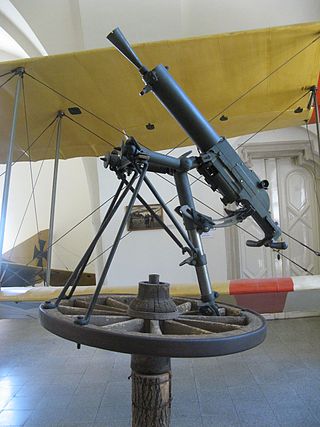
The Maschinengewehr (Schwarzlose) M. 7, also known as the Schwarzlose MG, is a medium machine-gun, used as a standard issue firearm in the Austro-Hungarian Army throughout World War I. It was utilized by the Dutch, Greek and Hungarian armies during World War II. It was routinely issued to Italian colonial troops, alongside the Mannlicher M1895 rifle.
The Type 97 heavy tank machine gun was the standard machine gun used in tanks and armored vehicles of the Imperial Japanese Army during World War II, a heavy machine gun by infantry forces, This weapon was not related to the Type 97 aircraft machine gun used in several Japanese Navy aircraft including the Mitsubushi A6M Zero, or the Type 97 automatic cannon used as an anti-tank rifle.

The Madsen is a light machine gun that Julius A. Rasmussen and Theodor Schouboe designed and proposed for adoption by Colonel Vilhelm Herman Oluf Madsen, the Danish Minister of War, and that the Royal Danish Army adopted in 1902. It was the world's first true light machine gun produced in quantity and Madsen was able to sell it in 12 calibres to over 34 countries. The gun saw extensive combat usage for over 100 years, with continued use in limited quantities worldwide into the 2010s. The Madsen was produced by Compagnie Madsen A/S.

The Besa machine gun was a British version of the Czechoslovak ZB-53 air-cooled, belt-fed machine gun.

The Colt–Browning M1895, nicknamed "potato digger" because of its unusual operating mechanism, is an air-cooled, belt-fed, gas-operated machine gun that fires from a closed bolt with a cyclic rate of 450 rounds per minute. Based on an 1889 design by John Browning and his brother Matthew S. Browning, it was the first successful gas-operated machine gun to enter service.

The ZB-30 and ZB-30J were Czechoslovakian light machine guns that saw extensive use during World War II.
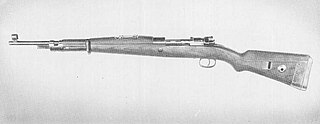
The puška vz. 33 was a Czechoslovak bolt-action carbine that was based on a Mauser-type action, designed and produced in Československá zbrojovka in Brno during the 1930s in order to replace the obsolete Mannlicher vz. 1895 carbines of the Czechoslovak četnictvo (gendarmerie). The manufacturer's designation was vz. 16/33. Another version, the Vz. 12/33, was also produced for the Latin American market.

The Universal Machine Gun Model 1959 is a general-purpose machine gun developed in Czechoslovakia in the 1950s. It remains in use by the Czech Army and the Slovak Armed Forces.
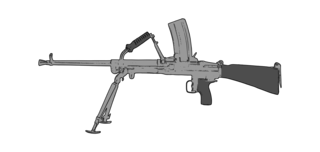
The vz. 52 is a Czechoslovak light machine gun developed after the Second World War for the Czechoslovak Armed Forces.

The Hotchkiss M1922 was a light machine gun manufactured by Hotchkiss.

The ZB-53 was a Czechoslovak machine gun. A versatile weapon, it was used both as a squad support weapon, as a mounted machine gun for tanks and other armoured vehicles, and on fixed positions inside Czechoslovak border fortifications. Adopted before the World War II by the armies of Czechoslovakia (as TK vz. 37) and Romania, it was also license-built in the United Kingdom as the Besa machine gun. Following the German invasion of Czechoslovakia, large quantities of the weapon were captured by the Wehrmacht and used during the war under the designation of MG 37(t).
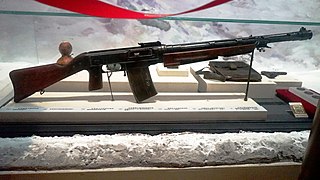
The SIG KE7 is a light machine gun designed and manufactured in Switzerland in the decade before the Second World War. Although exported, it was never used by the Swiss Army.

Václav Holek was a Czech firearm engineer. He had applied for more than 75 patents during his active years.



